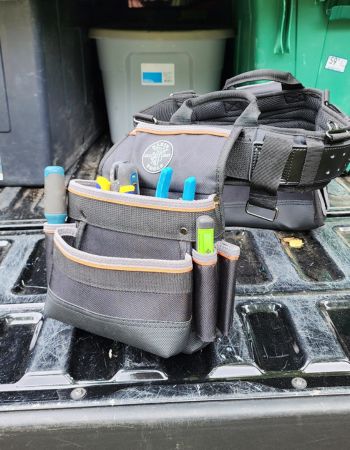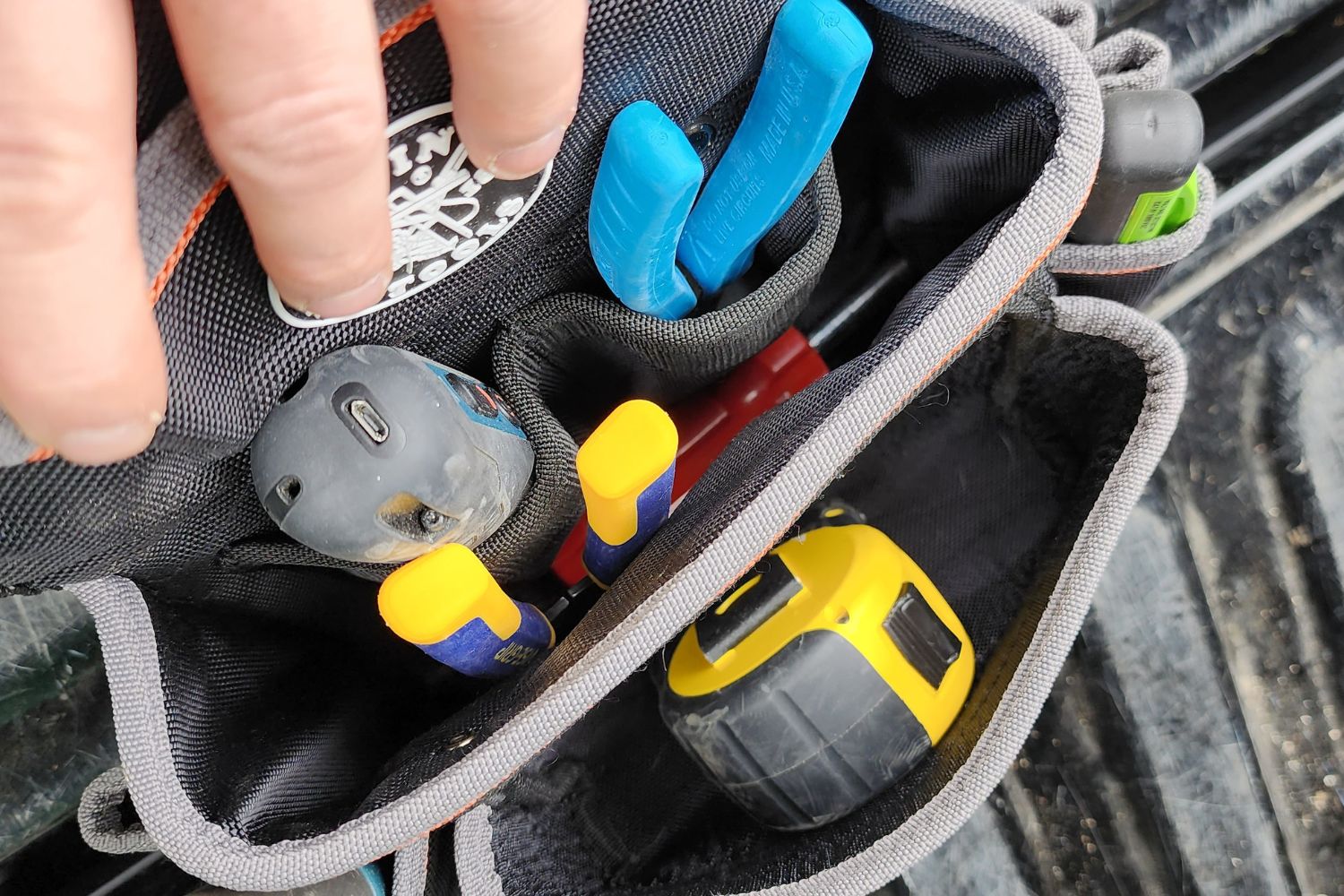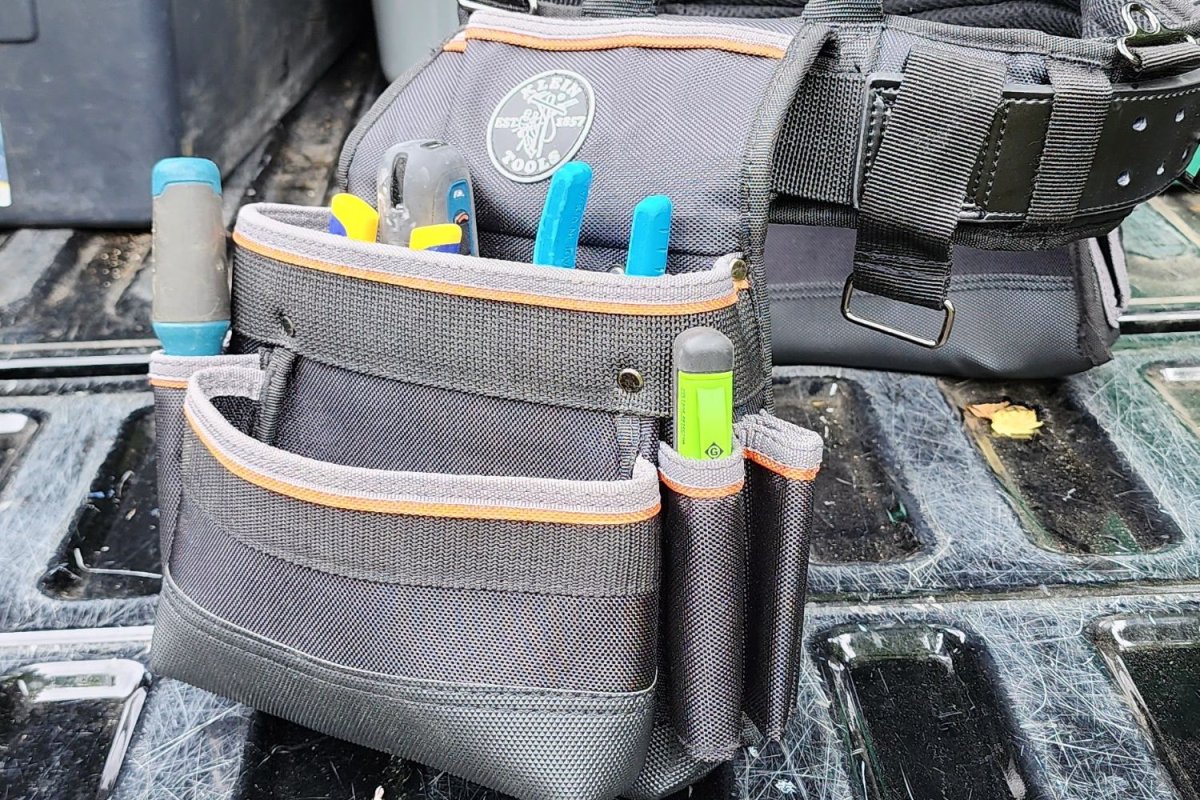We may earn revenue from the products available on this page and participate in affiliate programs. Learn More ›
While small electrical jobs rarely require more than a tool or two, big jobs are different. Whether it’s wiring an entire home, installing a panel, or crawling through a knee wall to install some recessed lighting, bringing all the necessary tools along for the trip can boost workflow and increase productivity. To do that, though, the DIYer or electrician needs a trusty tool belt.
I decided to try out a highly regarded electrician’s tool belt and put it through its paces. I landed on the Klein Tools Tradesman Pro electrician’s tool belt, which was the Best Overall pick in our Best Electrician Tool Belts buyer’s guide. This belt is adjustable, has lots of pockets, and features heavy-duty construction.
But it’s also a little pricey for an electrician’s belt. So the question is, is it worth it?
Find out what I discovered while using the Klein Tools Tradesman Pro electrician’s tool belt. I’ll discuss what I like about it, what doesn’t work so well, and whether I think it’s worth the price.
Klein Tools Tradesman Pro Electrician’s Tool Belt: At a Glance

Rating: 9.75/10
PROS
- Excellent materials, including a thick leather and nylon belt, as well as ballistic nylon fabric
- Pouches feature structured pockets as well as hook-and-loop adjustability that holds the bags in place for a custom fit
- Built-in drill bit holder makes accessing common drill and driver bits quick and easy
CONS
- Stitched-in suspender loops limit adjustability and potential comfort
Get the Klein Tools Tradesman Pro electrician’s tool belt at:
What is the Klein Tools Tradesman Pro electrician’s tool belt?
The Klein Tools Tradesman Pro electrician’s tool belt is a standard-style tool belt. It consists of two main pouches that hang at either hip, an adjustable padded carrier, a nylon belt, and a hammer loop on the back. Altogether, there are 12 pockets and 24 tool holders, allowing electricians and DIYers to load this belt with as many electrical tools and hand tools as needed.
The belt itself consists of thick nylon and extremely thick leather, ensuring that it’s able to handle the weight of the pouches when fully loaded. That belt then slides through the belt loop of a padded carrier with a hook-and-loop closure as well as hook-and-loop strips along its exterior. The exterior strips line up with a corresponding strip on the back of the tool pouches, allowing users to place their pouches toward the front or back of the carrier. Once the actual belt is tightened, the belt holds the pouches in place.
The carrier also has a few built-in features. These include built-in handles made from rolled nylon as well as built-in suspender rings. Also, the padded foam has a mesh face to promote airflow and comfort while it’s in use.
This Klein tool belt is available in a few sizes, including medium, large, and extra large, allowing most users to find a size that serves their purpose.

How easy is the Klein Tools electrician’s tool belt to set up?
I tested some of the best electrician tool belts around the time that I started reviewing the Klein, so I have a fairly fresh and comprehensive understanding of the challenge involved in setting each of them up. Among others I’ve used, the Klein tool belt is one of the easiest models to set up.
First, because it comes in different sizes (medium, large, and extra large) instead of one-size-fits-all, there isn’t a lot of strap or belt adjustment. Moving the pouches forward or backward simply requires pulling them off the hook-and-loop strip and repositioning them. There’s no need to remove the main belt from the pouches, so putting them in position is simple. Users who want to keep it light, though, can easily remove one of the pouches and the hammer loop and reattach them when heavy-duty work is at hand.
Also, putting this tool belt on is easy. There is a hook-and-loop closure that overlaps, allowing the user to position the belt temporarily before cinching down the actual belt. The belt itself has around 18 inches of adjustability, and in all honesty, the leather is so thick that tightening can be a challenge at first. However, the concept is as simple as tightening a belt.
Is the Klein Tools electrician’s tool belt easy to use?
I performed a series of tests with the Klein tool belt to determine how easy it is to use. I climbed ladders and jumped from a truck bed, as well as wired a mock outlet, installed mock recessed lighting, and did some mock house wiring. All the while I pulled tools out and put them away, assessing how easy it is to access everything I needed along the way.
Overall, I thought the Klein electrician’s belt was very easy to use. Storing tools in the different pockets was easy thanks to the main pockets being structured for easy accessibility. Removing tools from the pouches was also easy, as the pouches are just snug enough to keep items in place without making them too difficult to remove one-handed. The hammer loop wasn’t ideal for my taste, but since I never use rear-hanging hammer loops, that is really a subjective point.
While everything worked very well, one complaint I might register is that there aren’t enough tool holders inside the pockets. I’m a fan of tools having specific pockets, and there just isn’t enough of that for my taste. However, the built-in drill bit holder is a great idea, as it flips down where it can display the user’s favorite or most commonly used drill bits and driver bits.

How comfortable is this electrician’s tool belt?
While functionality is obviously paramount, comfort isn’t all that far behind. After all, many wear their tool belts for 8 hours or even double shifts, which means they really have to be comfortable.
The Klein’s padded carrier belt is very comfortable. It has thick padding and a mesh lining. This allows the user to tighten it down so it’s snug without discomfort while also allowing a bit of airflow and moisture wicking between the belt and the skin.
The one thing that could potentially make this belt more comfortable is a set of suspenders. However, the suspender rings are stitched into the carrier belt, which means that I wasn’t able to adjust them to how I would like it. Most other tool belts feature free-floating suspender rings, allowing users to position them wherever they need them. Adjustability is important in a tool belt design, and it’s my main complaint about this tool belt.
Is the Klein Tools electrician’s tool belt good quality?
The Klein tool belt features ballistic nylon fabric, which makes it durable to stress from weight as well as abrasions. It has some rivets, but it mostly features nylon stitching and bar-tack stitches that give it most of its strength. Also, the bottom of each pouch is reinforced with a rubber coating, ensuring that tools don’t poke through the bottom or that sharp objects can’t poke into it.
It’s worth mentioning again that the leather belt end is so thick that it does take an extra second or two to tighten this belt. The belt end then connects to a thick, wide nylon belt that is more than capable of handling this belt’s purpose. I would’ve rather seen more rivets, but overall, it is high quality and should last more than a few years.

Is the Klein Tools Tradesman Pro worth the price?
Let’s be clear: This tool belt, which primarily consists of nylon and some stitching, really isn’t a budget-minded tool belt. Given the materials, it’s a bit expensive, especially considering there are models from other brands that offer similar materials for less money. However, those are also lower-quality bags with thinner nylon, poor design, and less adjustability.
So is it worth the price? Yes, it is.
It’s a high-quality tool-storage option with plenty of adjustability, between the belt size and the pouch positioning. Accessing tools one-handed from a ladder or while crouching by an outlet is easy, and storing them away is fairly intuitive, even when considering a bulky meter. The drill bit holder might seem like a bonus, but when working in a tight spot, having the driver bits on hand to keep working without backing out is a huge boost in workflow.
Ultimately, it’s a design that’s probably going to tick a lot of boxes for pros and DIYers alike, and while the price is a bit higher than that of some other nylon bags, its design makes it worth the price.

Is the Klein Tools Tradesman Pro electrician’s tool belt right for you?
When considering whether the Klein Tools Tradesman Pro electrician’s tool belt is worth it for you, there are a few points to ponder. The first is obvious: If you don’t have a lot of electrical tools or work on many electrical projects, no, this belt isn’t worth the expense. In this case, it’s better to go with a belt that has a single pouch for less than half the cost.
Also, if you’re a person who needs each tool to have a single pocket or holder designated for it, or if you work in industrial or commercial electrical fields, this set might not be ideal. A set of pouches such as the Occidental Leather 5590 commercial electrician’s set might be a better fit.
Alternatively, if you spend a lot of time installing multiple devices on projects, are handling electrical installations in your own newly constructed home or addition, handle electrical rough-ins professionally, or work as a plant or building electrician, this belt can be worth it. It’s adjustable and comfortable for all-day work and has storage for all the necessary tools.
And for light-duty work, users can even remove one of the pouches to keep things a bit more streamlined. It’s also worth considering for pros who already wear heavy leather tool belts and would prefer something a bit lighter that’s more heavy-duty than a DIYer’s tool belt.
Where to Buy the Klein Tools Tradesman Pro Electrician’s Tool Belt
Get the Klein Tools Tradesman Pro electrician’s tool belt at:
Meet the Tester
Tom Scalisi is a full-time DIY and construction writer for many of the largest websites in the industry, including BobVila.com, This Old House, Family Handyman, and Forbes as well as his own pest control blog. He spent years working in the trades and industrial maintenance, which means he has a solid background in electrical tools and the belts that carry them.


